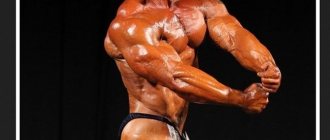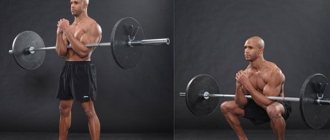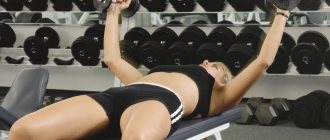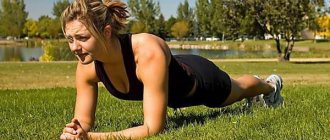to swing correctly in the gym, since the result of your workouts directly depends on it. But the correctness of training is determined not only by general, but also by individual factors. Thus, for a beginner athlete, a correctly constructed split is one thing, but for a more advanced athlete it is completely different, and the stage of training should also be taken into account. Some rules apply to gaining muscle mass, others when working on strength indicators, and others when working on quality. It is important to note that it is impossible to consider training separately from recovery, since the training process is a system of loads and adaptation. During training, you create stress, which triggers the process of synthesis of contractile proteins, but at the end of it, an even more important stage begins - recovery, on which, in fact, your progress depends. If you train correctly, but then do not recover, then instead of growth, regression will occur, and constant training in the under-recovery mode will generally lead to a training plateau.
In this article you will learn how to properly lift in the gym, taking into account the fitness level, training goal and recovery capabilities of the athlete. You will also learn general training rules that should be followed regardless of the specific training program. However, not all of these recommendations are regulatory in nature, since each person has different genetics and reacts differently to training stress. A very large number of factors play a role here, from muscle composition to pharmacological support. But there are also rules that are always fair! For example, progression of loads and systematic training. At the same time, there are rules that you need to take into account, but this does not mean that they cannot be adapted to suit you. On the contrary, it is possible and necessary, and for this you need to follow one more inviolable rule - keep a training diary!
How muscles grow
At high magnification, it is clear that the muscles consist of many small threads. Each “thread” is a separate cell, very long. Muscles become larger when each cell becomes thicker. And they can become thicker for two reasons.
1 Inside each cell there are even smaller “strings”. They run parallel to each other and are called myofibrils. They contract inside the muscle cell and provide movement.
2 Myofibrils inside each cell are surrounded by a liquid nutrient medium - sarcoplasm. It accumulates and supplies them with energy for work. Sarcoplasm can also increase in volume, as if inflating the cell from the inside and making the muscles visually larger.
High repetition training with light weights is very energy intensive and uses up a lot of energy (glycogen). In response, the body will try to accumulate it in reserve. This stretches the muscle cells over time, creating the appearance of "bloated" muscles (which are thought to "deflate" quickly if you stop exercising).
Training with heavier weights and lower repetitions increases the number of contractile proteins - myofibrils.
This is where the idea came from that high-repetition training with light weights only gives “false” muscle growth, and heavy weights are the only thing that grows real muscles, which is wrong.
Many studies confirm that there is no difference in growth between both approaches (, , , , , ). There is an assumption that the increase in fluid in muscle cells stretches the cell membrane. This is perceived by the body as a threat to the integrity of the cell, so it responds with anabolic signals, which triggers (under other conditions) muscle growth.
Another complaint about high-repetition training is that it targets “slow” fibers, which are resistant to fatigue, are unable to generate much force, and grow poorly. And they do not include “fast”, well-growing fibers. But heavy weights include fast-twitch fibers, so they are better for muscle growth.
There is some truth to this, but it's not quite as strict: high-rep training can also turn on fast-twitch fibers, but only when you work to real and complete failure. As the slow fibers get tired, the fast fibers are activated.
So, you can build muscle with high reps and light weights, but you'll have to train to failure on every set, and the intense burning sensation in the muscle isn't the most pleasant feeling.
The number of repetitions is not important if they are done to failure
Other scientists have used a similar basic training program (Study #5). 25 healthy people aged 34-44 years with at least 1 year of resistance training experience were divided into only 2 groups: low and high repetitions, the group with medium repetitions was excluded.
Ultimately, after 8 weeks of training, a 10% increase in quadriceps femoris cross-sectional area was found in both groups, with no significant differences.
A follow-up study from the same laboratory (#6) with a similar sample of subjects reported a 10% increase in quadriceps muscle size, with no significant differences between groups that used a similar training protocol.
The researchers believe that the results differ from the data we described in the previous example due to the lack of training of older people, as a result of which any type of resistance training in this population can provide a significant stimulus for muscle growth.
Notably, subsequent studies using a similar protocol in healthy young adults showed an 18% increase in satellite cell numbers associated with low-intensity (higher repetition) training. Therefore, exercises with light weights and high repetitions, done to the limit, can have a positive effect on the early stages of the muscle tissue formation process.
conclusions
You can work in any rep range as long as you work the muscles more than usual and progress in the load.
Usually, few people are faced with a choice: either heavy weights or high repetitions. If you want to gain muscle as quickly as your genetics will allow, lifting fairly heavy weights (60% of your one-rep max and above) should be part of your training. But adding higher reps can improve results because you'll be developing all the fibers and using all the muscle growth mechanisms.
https://youtu.be/wd43sLpO6bA
60-75% of the repetition maximum gives the best effect
In the traditional approach to training, to significantly increase muscle size requires an intensity level of about 60% of your maximum, which you can do only once (which corresponds to about 10-12 repetitions). Presumably this is the minimum level required to activate the full range of muscle fibers.
During the study (link #1 below the text), the effect of training intensity on a wide range of loads was determined: from 20% to 90% of the maximum working weight of the subjects.
At a load intensity of 20% they performed 3 sets of 27 repetitions, at 40% - 3 sets of 14 repetitions, at 60% - 3 sets of 9 repetitions, at 75% - 3 sets of 8 repetitions and at 90% - 6 sets of 3 reps. Thus, the total amount of work (total amount of weight lifted) was the same in all five cases.
As a result, the increase in muscle protein synthesis was minimal after exercise at 20% and 40% intensities, but increased significantly at 60% and reached a plateau. In other words, with a further increase in the load as a percentage of the maximum weight that the subjects could take, there was no significant increase in muscle protein synthesis.
The results were consistent across both young and older adults, confirming that the stimulating effects of exercise peak at ~60-75% of maximum body weight.
It's not the maximum progression that's important, it's the progression in principle that's important. Please understand this once and for all...
Here, first of all, I need to inform you that the progression of the load is achieved not only by increasing the WEIGHTS on the barbell, dumbbells, machines, kettlebells and other equipment (this is simply the simplest, most common and most understandable/known way) but also by many other ways.
You can see a complete list of all the methods and their applications in practice in my main article: “What is load progression, its types, application and much more.” After studying this article, you will understand how to use this LOAD PROGRESSION in PRINCIPLE to grow your MUSCLES!
Which is more effective?
Before we draw any conclusion, let’s try to compare some exercises with each other and analyze them:
Bench press.
The trick here is that during the bench press, not only the pectoral muscles work, but also the deltoids, triceps, and small muscles of the upper back. Yes, the main thing that gets tensed is the pectoral muscles. But other muscles are specifically involved in allowing us to squeeze the barbell to the top point. To do this they must be strong. In short, muscle strength must be balanced.
Firstly, progressive overload is more difficult from a practicality point of view. It's easier to visualize progress by knowing when you've increased the weight of an exercise, whereas increasing reps or changing variations may not be as noticeable. Moreover, it is not a question of if, but when the need to increase the resistance of the exercise arises. Most people can actually go further than they think about weight training, but eventually they will hit a ceiling.
Pull-ups with hands behind back
Even if you can only progress on one exercise, the second disadvantage comes down to the return on investment of your time. For any strength training, there is a spectrum of how much work you can do and how hard you can push it. On one end of the spectrum you have high volume training - lots of sets, and on the other end you have high intensity training - really very close to muscle failure on every set. In other words, you can train with many sets or workouts where you will be as difficult as possible.
Moreover, these muscles must contract simultaneously and harmoniously. This is called muscle coordination. But the bench press alone cannot develop muscle coordination and balanced muscle strength. Therefore, beginners who are just starting to do the bench press can lift initial weights, but up to weights of 120-150 kg. and higher, they are unlikely to reach. The bench press serves as a measure of your overall fitness and is a purely strength exercise. For this reason, the bench press was chosen as a competitive exercise.
Although high volume and high intensity programs will lead to hypertrophy, high volume programs require longer training sessions. For example, if you already find push-ups and dips easy, you can do the workout with dumbbells and weighted dips at one and a half times.
Finally, many of the best exercises cannot be done with body weight. For example, the barbell row is often called the king of exercises because it works so many different muscle groups. Unfortunately, there is no true bodyweight equivalent for barbell deadlifts. Of course, you could find a way to work each of these muscle groups individually, but again your workouts will be longer.
Dips.
If you pay attention to muscle training during push-ups on the uneven bars, then it’s a completely different story. You can't cheat here anymore. If any of the muscles involved in this exercise are poorly developed, then you will perform very few repetitions, or none at all. In this exercise, the load on all muscles is distributed ideally. That is why dips can be called the best exercise for developing chest muscles. Let's pay attention to other points.
Knowing all the facts, here's what you should do if you're interested in weight training. Use the information above to determine how effective a workout is for your body. If you're a newbie who's been intimidated at the gym, then weight training is a great place to start. If you already have some strength training and don't have a lot of time, it's best to use free weights. Find a program you like and stick with it. great program, but you have your own gym, starting body weight and weight room. Free workouts are also great. It's always important to stick to one strength training program, but this is especially true in bodyweight exercises, where progressions can add an extra layer of difficulty. Don't attempt it yourself if you don't know what you are doing. Make sure you have your nutrition. Remember, exercise is just one part of the equation. In fact, if your main goal is to lose weight, find out when to move up to free weights, if possible. Once you have made progress, you can switch to free weights to reach a certain level. Recognize that weight training may just be a step toward a program that's right for you. Write a program and stick to it. . As we mentioned earlier, there is no best program, diet or exercise.
Equilibrium.
If you ask any professional strength athlete, he will confirm that the main thing in the success of any strength exercise is balance. Take, for example, the same bench press. You need to keep your feet firmly planted on the floor. This will give you more confident stabilization of the shoulder girdle, which will allow you to squeeze the barbell with greater force. Thus, the main goal of this and other strength exercises is to maintain balance. There is an invisible struggle going on for this. If we are talking about training with your own weight, then maintaining balance becomes irrelevant. After all, when we do push-ups or pull-ups, we have no support under our feet. Priority is given to the coordinated work of the muscles, and this is much more effective than trying to maintain balance.
When it comes to fitness and health, it depends on the person. It's absolutely true that core training will build muscle, but definitely take your time, budget, and consideration into account when choosing a program that's right for you. While strength training is often synonymous with looking big and ripped, it's not the only way to get there. Strategic use of bodyweight exercises can be just as effective, if not more so, than traditional stalwarts like the bench press and squats.
These athletes are some of the most ripped on the planet, and they don't use weights. Many modern programs make it safe and effective to break without adding weight. Gravity, not weight, is what we use to build muscle. Gravity creates resistance in our atmosphere, and this resistance can also be called weight. This is why the technical term for weight training is “resistance training.” Weights are simply tools that are used in the resistance training process.
Figure.
Training your muscles with your body weight can quickly create an athletic body profile. To get a narrow waist, six-pack abs, broad shoulders, you only need a few months of this type of training. Strength training can provide all this over a longer period of time.
In general, after reading this information, you yourself will be able to draw a conclusion about which training to give priority to. Although... It is best to combine muscle training with iron and weight training. This is the best option. And this is exactly the advice given by those who have tested this technique in practice. After performing exercises with their body weight, their strength indicators increased significantly.
They allow you to perform all types of resistance exercises easily and in confined spaces. They also allow you to choose the exact resistance, making them more versatile than if you were simply relying on body weight and gravity. However, they can be limiting and often. Body weight resistance training uses more natural movements. It makes your body move functionally or in a way that helps your functionality in life. With a little creativity, you can get all the benefits of weight training, plus the benefits of functionality, and add "lack of equipment" to your pile of bad excuses.
Of course, you shouldn’t leave the iron, but you shouldn’t forget about the bars and horizontal bars either. Do more pull-ups, dips, and other exercises that use only your body weight. When doing pull-ups and dips, use additional weights that you can hang on yourself. You will feel the effect of this very soon! How do you conduct your training? Exclusively with iron, your weight, or a combination? Share in the comments, friends...
If you are going to pump up your stamina and health
If you don't need bench and squat records and prioritize health and endurance, choose 15+ reps with light weights—about 30-50% of the weight you can lift once.
This intensity is good for beginners, injured and older people, as well as those returning to strength training after a long break.
By working with light weights, you reduce the risk of injury due to errors in technique and reduce stress on your joints and spine.
Strength work 20-25 times per set increases Aerobic Endurance Training Strategies muscle endurance - the ability to work longer without fatigue. And it pumps up intermuscular coordination—your body’s ability to tense and relax the right muscles in a timely manner. This helps improve performance and reduce the risk of injury in endurance sports.
Many people think that working with light weights excludes building muscle mass. This is wrong. In fact, by doing high reps you can build muscle just as effectively as using a heavier barbell. But only under certain conditions.











